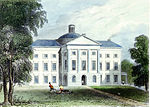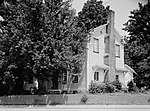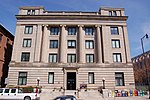Christ Episcopal Church (Raleigh, North Carolina)
19th-century Episcopal church buildingsChurches completed in 1848Churches in Raleigh, North CarolinaChurches on the National Register of Historic Places in North CarolinaEpiscopal church buildings in North Carolina ... and 6 more
Historic district contributing properties in North CarolinaNRHP infobox with nocatNational Historic Landmarks in North CarolinaNational Register of Historic Places in Raleigh, North CarolinaRichard Upjohn church buildingsUse mdy dates from August 2023

Christ Episcopal Church, also known as Christ Church on Capitol Square, is an Episcopal church at 120 East Edenton Street in Raleigh, North Carolina. Built in 1848–53 to a design by Richard Upjohn, it is one of the first Gothic Revival churches in the American South. The church was built for a parish established in 1821; its minister is the Rev. James P. Adams. It was declared a National Historic Landmark in 1987.
Excerpt from the Wikipedia article Christ Episcopal Church (Raleigh, North Carolina) (License: CC BY-SA 3.0, Authors, Images).Christ Episcopal Church (Raleigh, North Carolina)
East Edenton Street, Raleigh Warehouse District
Geographical coordinates (GPS) Address External links Nearby Places Show on map
Geographical coordinates (GPS)
| Latitude | Longitude |
|---|---|
| N 35.780891666667 ° | E -78.637511111111 ° |
Address
Christ Episcopal Church
East Edenton Street
27601 Raleigh, Warehouse District
North Carolina, United States
Open on Google Maps









